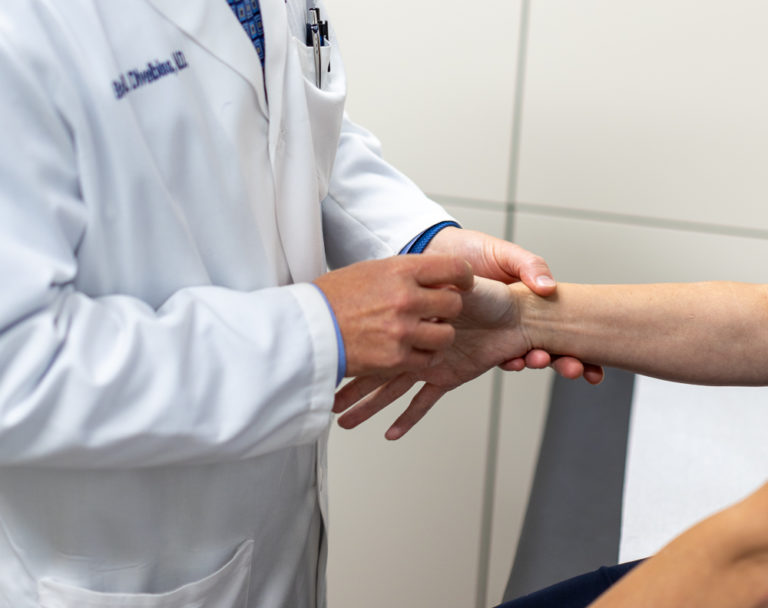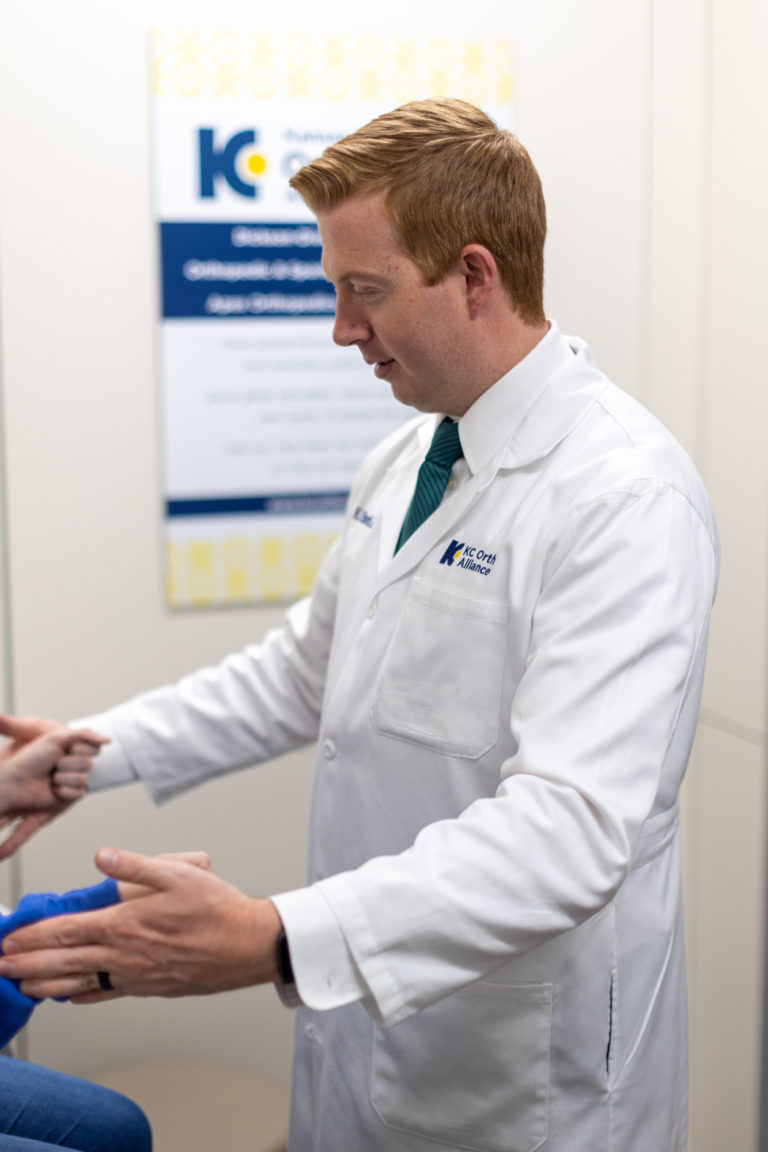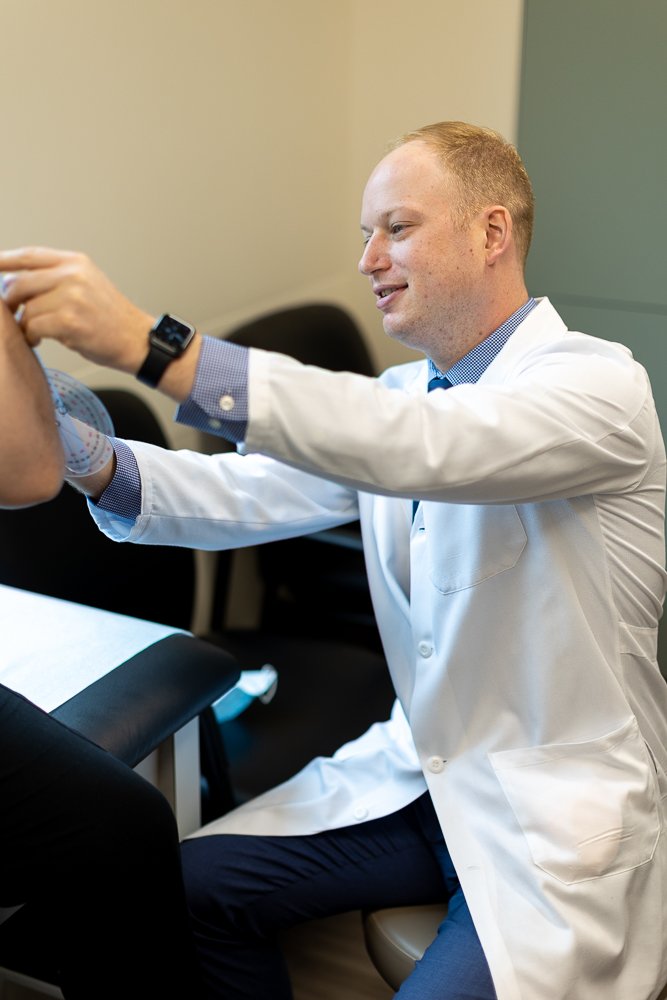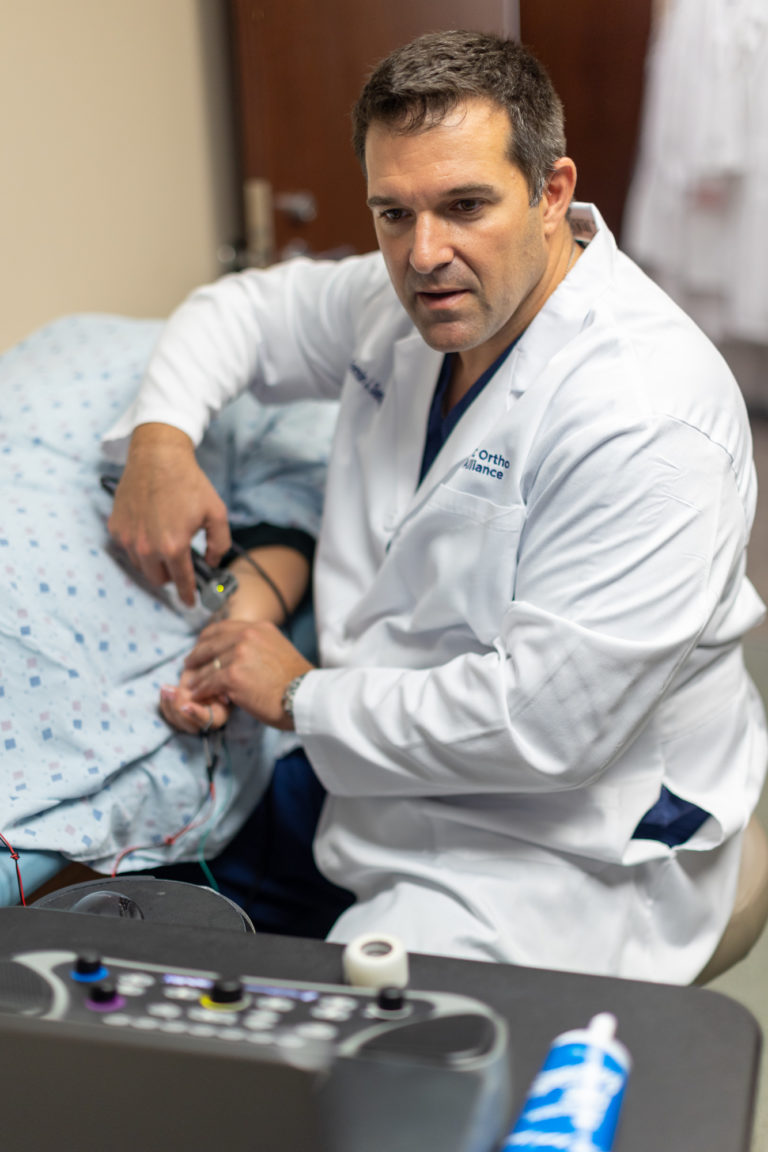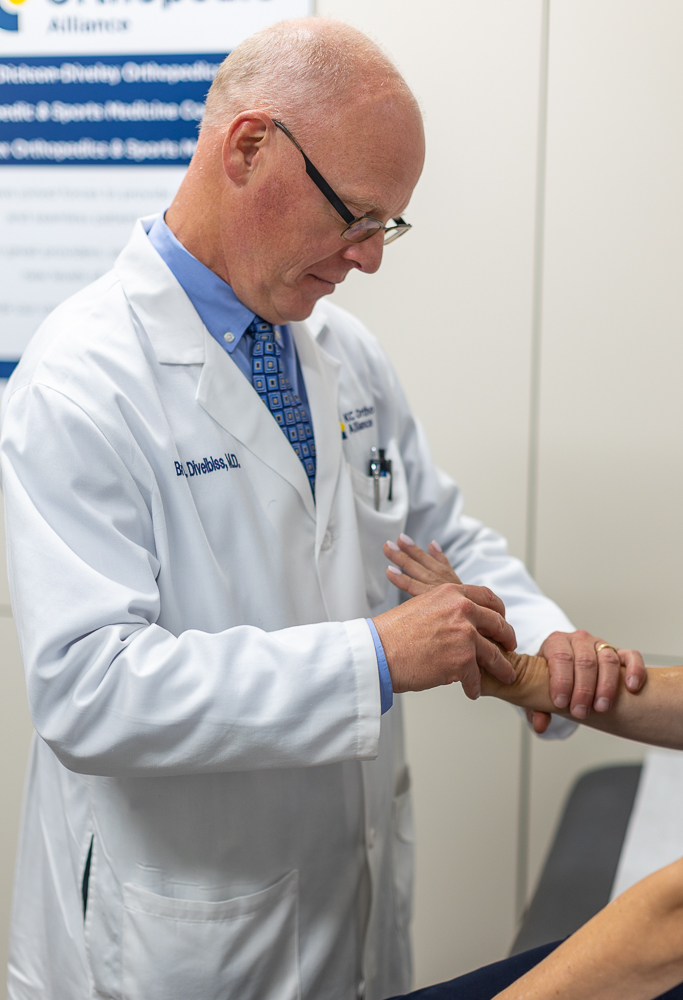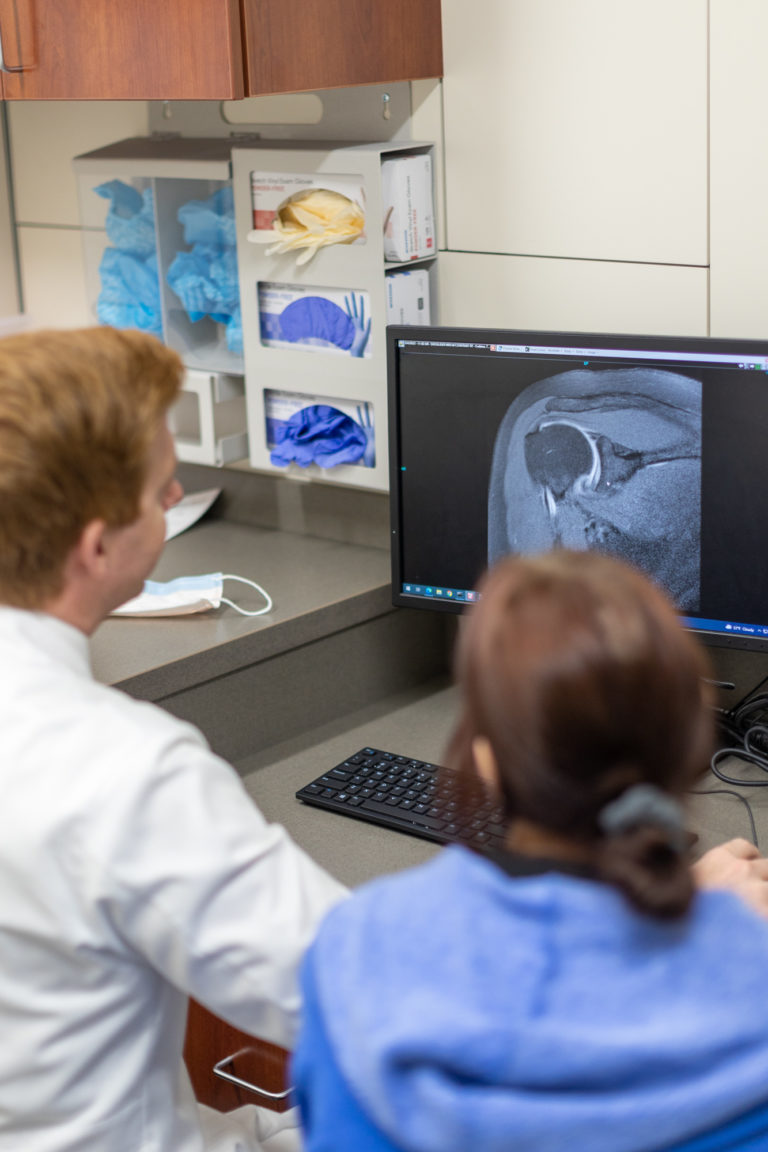Wrist Arthroscopy in Kansas City
Wrist Arthroscopy
Your Solution to
Hand & Wrist Discomfort.

Understanding the Basics Behind Hand & Wrist Pain
What is Wrist Arthroscopy?
Wrist injuries are often classified as being either acute or chronic. An acute injury occurs as the result of a single incident, like a fall during sports or a strain doing a daily task. Chronic wrist conditions often develop as the result of repeated micro traumas over a period of time.
Both conditions can worsen if left untreated and can greatly impact your function. Regardless of wrist issues you’re dealing with—whether it’s a sprain, strain, fracture, ligament tear—help is available. The highly skilled providers at Kansas City Orthopedic Alliance can help you find the necessary treatments to get you back to pain-free living.
Our providers believe in utilizing conservative approaches to managing wrist injuries whenever possible. If it’s determined that a wrist arthroscopy in Kansas City is the right treatment for you, we’ll create a treatment plan based on your individual needs, symptoms, and goals.
Your First Appointment for Hand & Wrist Injuries
Choosing a wrist arthroscopy in Kansas City is a decision that typically involves guidance from your primary care doctor and orthopedic physician. When you choose Kansas City Orthopedic Alliance, one of our highly-trained orthopedic hand and wrist specialists will conduct an initial evaluation to better understand your condition. After a complete review of your results, your provider will discuss whether wrist arthroscopy is the best treatment option for you.
Common injuries that may require a wrist arthroscopy include:
- Torn ligaments
- Instability
- Fractures
- Loose bodies in the joint
- Misalignment
- Ganglion Cyst Removal
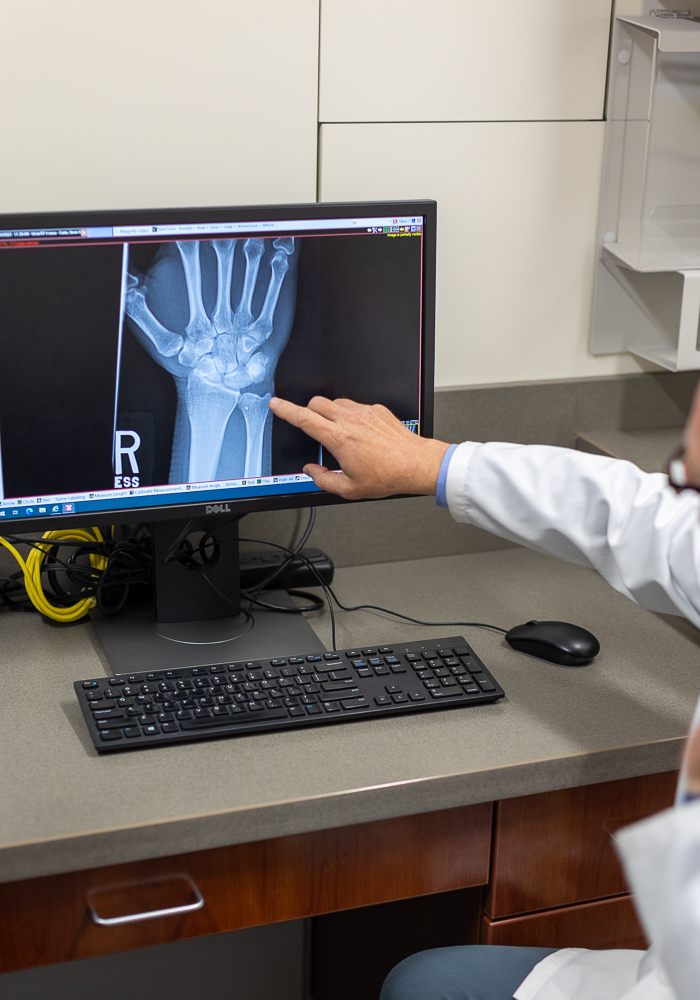
Kansas City Orthopedic Alliance hand & Wrist Assessment
Assessing the Injury
Determining the proper treatment process for hand and wrist injuries starts with an assessment from one of our experienced providers. You can think of hand and wrist pain as a spectrum, with some instances being more severe than others.
The KCOA orthopedic specialists always focus on each patient and their concerns before creating a treatment plan.
Therefore, during your initial appointment, we will often ask questions such as:
From there, we can decide what treatment option will align best with your needs and lifestyle goals.
- Does your pain currently limit you or your activities?
- Has your pain progressed or worsened recently?
- Did you notice or hear a popping sound at the time of your injury?
- Have you noticed any change in your symptoms that has made it more challenging to function?
- What are your lifestyle goals?
- How has pain affected those goals?
Examination
Once we’ve completed a proper assessment, your provider will often begin with a physical examination to help determine the origin point of your pain. In some cases, advanced testing may be necessary for a complete diagnosis. This may include:
X-Ray
Also called radiographs, an X-ray captures a picture of the wrist. Orthopedic physicians may order an X-ray to rule out the possibility of a fracture (broken bone), osteoarthritis, or other bone-related conditions.
Magnetic Resonance Imaging (MRI)
MRI captures images of muscles, bones, ligaments, cartilage, and tendons to help provide information other tests can’t detail. During an MRI, you will lie on a table that slides into a tube-shaped scanner. The machine creates a magnetic field around you, using pulsed radio waves to form the MRI images.
Symptoms
Common Signs and Symptoms of Hand & Wrist Injuries
There are numerous potential causes of pain when it comes to hand and wrist injuries. Similar to other areas of your body, there are a number of different parts working together in your hand and wrist, leading to many different chances for injury or chronic pain. Each of these causes comes with its own distinct set of symptoms.
Wrist arthroscopies are a relatively common procedure performed at clinics across the country, and successful ones can treat a number of issues to provide long-term relief. While our preference at KCOA is always to find non-surgical ways to treat pain, wrist arthroscopy may be necessary if a patient’s wrist doesn’t respond to these treatments. Hand and wrist injuries can also worsen based on certain risk factors, such as age, activity level, whether you’re a healthy weight, and more.
Causes
Causes of Hand & Wrist Pain
The body has a number of different joints that all work in unison in order to function normally.
The hand/wrist, in particular. is a complex area with numerous joints, ligaments and nerve structures that are potentially at risk for injury. The severity of your hand and wrist pain will vary depending on a few different key factors, including both the location and the source of the problem.
Whether you’re suffering from an acute or chronic injury, the hand and wrist specialists at Kansas City Orthopedic Alliance are here to assist. We’ll help you find the root cause of your pain and determine whether a wrist arthroscopy or another treatment process is right for you. Common causes of hand and wrist pain include:
Treatment Alternatives
In most cases, surgery is not the first option for treatment at Kansas City Orthopedic Alliance. If we can treat your hand and wrist issues with more conservative treatments, we’ll choose those options. We typically exhaust all non-surgical options prior to recommending surgery.
Non-surgical treatments for the hand & wrist and include:
Occupational/Physical Therapy
A trained therapist will focus on the issue that’s causing the pain or symptoms as well as the deficits that are present as a result of the injury. Stretches, strengthening exercises, manual soft tissue work, and modalities like hot and cold therapy may help you recover.
Medications
Your doctor may recommend over-the-counter NSAIDs (Non-steroidal anti-inflammatory drugs, such as Advil) or prescription medications. Especially with NSAIDs, you should always talk to your doctor to ensure they are the right treatment for you.
Injections
Therapeutic injections can help reduce inflammation, and the effects tend to last for 3 to 6 months. During that time, we often encourage patients to work with a therapist to improve strength and flexibility, while their symptoms are being aided by the medication. Many people manage their pain with injections and physical therapy.
Regenerative Medicines
Regenerative medicines like stem cell injections or platelet-rich plasma can help nourish worn or damaged tissue. This option works best if you have mild-to-moderate wrist pain.
F.A.Q.
Frequently Asked Questions
Kansas City Orthopedic Alliance is here to help.
Our care is personal. Our team is knowledgeable. And we’re more available than ever.
With access to board-certified specialists across Kansas City, we have the tools to meet almost every musculoskeletal condition.
Our Locations
Overland Park, Kansas
10777 Nall Ave Suite 300 Overland Park, KS 66211Leawood, Kansas
3651 College Blvd. Leawood, KS 66211Kansas City, Missouri
Saint Luke's Medical Plaza #1 4320 Wornall Rd., Ste. 610 Kansas City, MO 64111Belton, Missouri
Belton Regional Campus 17067 S Outer Rd #301 Belton, MO 64012Blue Springs, Missouri
St. Mary’s Medical Center, Main Entrance 203 NW R.D. Mize Road, Suite 200 Blue Springs, MO 64014Shawnee Mission, Kansas
7450 Kessler St ste. 140 Merriam, KS 66204Prairie Star (Lenexa, Kansas)
Prairie Star 23401 Prairie Star PkwyBldg. B, Ste. 220 Lenexa, KS 66227

